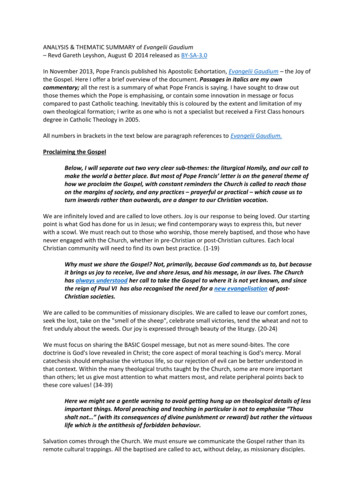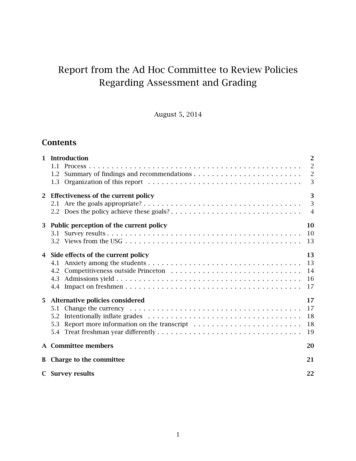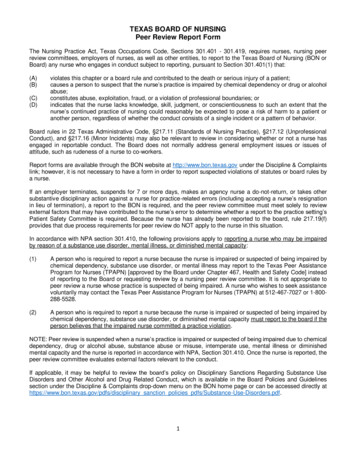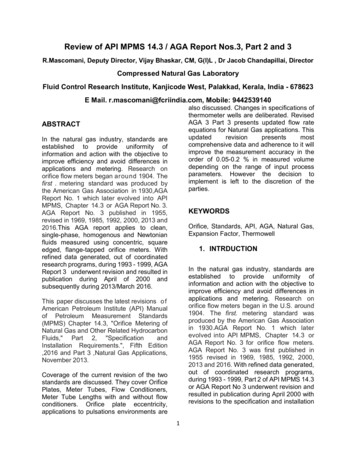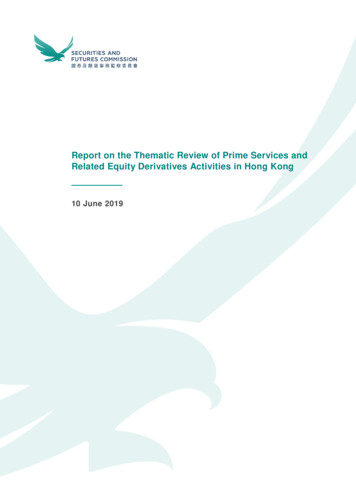
Transcription
Report on the Thematic Review of Prime Services andRelated Equity Derivatives Activities in Hong Kong10 June 2019
ContentsA. Introduction3B. The prime services industry landscape in Hong Kong5I.Prime services provided in Hong Kong5II.Prime services clientele and growth7III.Contracting entities8IV.Global support model8V.Sole or multiple prime brokers9VI.Trading strategies used by prime services clientsC. Findings and good practices1011I.Governance and management supervision11II.Client life cycle management14III.Margin financing18IV.Short selling and securities lending22V.Handling of client assets26VI.Risk management and controls292
A.Introduction1.In October 2017, the Securities and Futures Commission (SFC) commenced athematic review of prime brokers (PBs) to assess their practices, internal controls andrisk management processes. These PBs are financial institutions providing primeservices and conducting related equity derivatives 1 activities in Hong Kong.2.Generally, prime services include the provision to institutional clients, such as hedgefund managers, of trade execution and clearing, securities borrowing and lending,custody, financing solutions, synthetic prime services, reporting, capital introductionand consulting services.3.Hong Kong is typically the Asia hub for financial institutions’ equities businesses, withinwhich prime services tend to reside. As many prime services clients, includinginternational hedge funds and other institutional clients, have a strong presence inHong Kong, prime services provided locally to international clients conducting tradingor related activities in the Asia Pacific region are often managed in Hong Kong withoversight at the group level.4.While operating models for prime services can be complex and may involve multiplelegal entities of a financial institution across different jurisdictions, if clients are servicedin Hong Kong or if PBs are carrying out their prime services in Hong Kong, PBs areexpected to comply with the applicable rules and regulations in Hong Kong regardlessof where the risk positions are booked. In addition, PBs acting as the Asia hub toconduct business activities for their groups should also have adequate controls andprocedures in place to follow the standards established by their group companies tofacilitate the group companies’ compliance with the rules and regulations which applyto them.5.The scope of the thematic review primarily covered the following: 6.Governance and management supervision;Client life cycle management;Margin financing;Short selling and securities lending;Handling of client assets; andRisk management and controls.The thematic review was conducted in two phases:(a) A questionnaire was sent to 17 selected financial institutions operating in HongKong to collect information about whether they offered prime services, theirpractices in relation to the scope of services provided, their front-to-back businessprocesses and risk management frameworks for prime services and their relatedequity derivatives activities. According to the responses, 13 out of the 17institutions surveyed offered a full range of prime services in Hong Kong.(b) In the second phase, PBs with different business models were selected forprudential visits to further verify their responses to the questionnaire or on-site1 For example, PBs often utilise equity derivatives in the provision of their synthetic prime services toallow clients to synthetically obtain certain exposure.3
inspections to assess their key risks and validate their controls for the provision ofprime services activities.7.Together with the circular to intermediaries on prime services and related equityderivatives activities issued on the same day as this report, the SFC provides theindustry with a summary of the findings of the thematic review as well as examples ofgood practices and our overall expectations. The examples of good practices from thethematic review are non-exhaustive and PBs should not regard them as the onlymethods for complying with the regulatory requirements. PBs are also encouraged topay attention to the areas for improvement to avoid ineffective practices and internalcontrol deficiencies.8.As the financial market evolves, the SFC enhances regulatory requirements as needed.Market participants are reminded to continuously assess how regulatory changeswould affect the regulated activities they carry out in Hong Kong, especially in theprovision of prime services where the business processes could be spread acrossvarious jurisdictions or managed on a regional or global basis.9.The SFC will keep abreast of both local and global developments relating to primeservices and propose regulatory changes where appropriate.4
B.The prime services industry landscape in Hong KongI.Prime services provided in Hong Kong10.The initial core service of PBs was to provide margin financing. Over time, in order toretain hedge fund business, PBs diversified their operations to securities borrowing andlending (SBL) and synthetic prime services. All the PBs surveyed provided thefollowing services which were also their key revenue drivers (also see charts inparagraph 12):Synthetic primeservicesCore prime servicesMargin financing PBs providedfinancing to theirclients, allowing themto obtain the leveragerequired to supporttheir tradingstrategies. This could beachieved through theprovision of a marginloan within a creditlimit calculatedthrough a definedmargin methodologyand collateralised byassets posted by aclient to a PB.11.SBL PBs provided theirclients with access tolenders, such asinstitutional investorswith deep portfolios ofsecurities which couldbe used by hedgefunds to cover theirshort positions andfacilitate short sellingstrategies. Securities were lent ona collateralised basis.Transactions weremanaged by PBs andgoverned by asecurities lendingagreement. PBs allowed clients tosynthetically obtainexposure to a certainshare without buyingor borrowing thephysical share,especially in restrictedmarkets. This wasoften done through atotal return swaptransaction.Synthetic transactionsmay be margined on atransaction-bytransaction or portfoliobasis.In addition to the key revenue drivers mentioned above, most PBs also providedoperational support (eg, trade execution, clearing and settlement, custody services andaccount management services such as cash and position management, corporateactions and dividend event processing) and other ancillary services (eg, capitalintroduction 2 and business consulting 3).2PBs can introduce hedge fund clients to sources of funding, such as potential investors or capitalstreams from the asset and wealth management businesses of the PB’s group.3 PBs can provide consulting services to fund managers across the hedge fund life cycle from prelaunch through maturity and guide decision making.5
12.Based on our survey results, margin financing was the service most frequently used byclients, whereas synthetic prime services contributed the largest share of PBs’ revenue.Client usage of different prime services0% 10% 20% 30% 40% 50% 60% 70% 80% 90% 100%Margin financingTrade execution, clearing and settlementAccount managementSecurities borrowing and lendingCustody servicesSynthetic prime servicesCapital introductionBusiness consultingRevenue contributionOthers, 2%Synthetic primeservices, 46%Trade execution,clearing andsettlement, 8%Margin financing,19%Securitiesborrowing andlending, 25%6
II.Prime services clientele and growth13.According to the PBs surveyed, a majority of their prime services clients were hedgefunds, whose trading strategies and activities often required them to engage PBs asone of their key service providers.14.The remaining clients were mainly other institutional clients and family offices (seechart below).Prime services client typesFinancialinstitutions, 19%Hedge funds, 75%Others (eg, familyoffices), 6%From data collected in the SFC’s periodic surveys of the Hong Kong hedge fundindustry, the number of hedge fund managers and the value of total hedge fund assetsunder management (AUM) in Hong Kong grew significantly over the last decade. From2009 to 2018, total hedge fund AUM in Hong Kong more than tripled and the number ofhedge funds managed by SFC-licensed hedge fund managers in Hong Kong increased117% from 542 to 1,175. The growth of hedge funds contributed to the increasinglysignificant role played by PBs in the financial markets.Number of hedge funds and 004005428055.360AUM (USD billion)Number of hedge funds15.4020020002009AUM (USD billion)2018Number of hedge funds7
III.Contracting entities16.The contracting entity for the provision of prime services could be a securities firm or abank within a financial institution. The location of a contracting entity of a PB dependedon a number of factors, such as the country where the client was domiciled and thelocation of its key operations. Most PBs had contracting entities based in the UK (all 13PBs surveyed) and the US (10 out of the 13 PBs surveyed), and these were the mostcommonly used contracting entities for prime services clients globally and regionally.Some PBs had other contracting entities domiciled in Australia, France and Ireland.The centralisation of contracting entities allowed PBs to achieve higher efficiency inrisk management and significant savings through hedging, netting and offsettingpositions while reducing the overall risk profile of the their businesses and thereforetheir capital and liquidity requirements.17.In practice, US clients generally contracted with the US entity while all otherinternational clients mostly contracted with the UK entity. We observed that clientsserviced in Hong Kong were mostly Asia-based or international clients, and theseclients would generally contract with the UK entity of a PB.IV.Global support model18.Apart from serving Asia-based clients in the region, most PBs also offered “follow-thesun” support for their global clients where Hong Kong, as the regional equities hub,provided services to global clients which conduct trading in Asian markets. While theseglobal hedge funds were primarily based in the US or Europe, our survey shows asizable proportion were being serviced in Hong Kong.Percentage of global clients serviced in Hong Kong41% or aboveBetween 31% and 40%Between 21% and 30%Between 11% and 20%10% or belowTotalNumber of PBs21244138
19.The following table shows the distribution of the main operational locations of all theprime services clients, both local and global, serviced by the PBs from their Hong Kongoffices:Main operational locations of prime services clientsserviced in Hong KongAsia (excludingHong Kong,Singapore, Japanand Australia), 4%Australia, 4%Others, 2%Japan, 4%Singapore, 9%Hong Kong, 42%Europe, 11%United States,24%V.Sole or multiple prime brokers20.The 2008 global financial crisis highlighted concerns over counterparty risk exposure toPBs. As a result, prime services clients moved from maintaining a businessrelationship with a sole PB to contracting with multiple PBs (multi-prime) to diversifytheir counterparty risk. According to information collected by the SFC, multi-prime hasbecome a model of choice for most clients over the past decade.Percentage of prime services clients using multi-prime100%90%80%2008 6200920189
21.The multi-prime model increased competition amongst PBs, especially for highperforming clients. Clients might transfer assets to another PB with more suitabletechnology, services which focused on their strategies or which provided financing atbetter rates. This also provided clients with access to a wider range of products andmarkets.VI.Trading strategies used by prime services clients22.Prime services clients adopted various trading strategies (see chart below).Trading strategies of PB clientsMulti-Strategy,24%Relative value, 6%Equity long/short ,49%Global macro, 5%Event driven, 5%Others, 2%Credit/ leveragedcredit, 2%Quant/ highfrequency-trading,4%Statisticalarbitrage, 3%10
C.Findings and good practicesI.Governance and management supervision23.As a business line, prime services were typically grouped under PBs’ equitiesfranchises. The oversight of prime service activities could be specific (eg, withdesignated governance committees), or could be included as part of the overalloversight of PBs’ equities franchises.Expected standardsPBs should ensure adequate and effective management and supervision over primeservices activities. While operating models for prime services can be complex andmay involve multiple legal entities of a financial institution across differentjurisdictions, if clients are serviced in Hong Kong or if PBs are carrying out theirprime services in Hong Kong, PBs are expected to comply with the applicable rulesand regulations in Hong Kong regardless of where the risk positions are booked. Inaddition, PBs acting as the Asia hub to conduct business activities for their groupsshould also have adequate controls and procedures in place to follow the standardsestablished by their group companies to facilitate the group companies’ compliancewith the rules and regulations which apply to them.Sufficient management oversight 4 should be in place to ensure that matters relatedto prime services activities are brought to management’s attention for timely review,and there is adequate accountability for the business and related risks 5.Where the oversight of a certain process is performed by a committee, PBs shouldclearly define the roles and responsibilities of the committee and ensure thecomposition of the committee is appropriate to provide proper oversight.Effective policies and procedures should be established to identify and manage theconflicts of interest 6 relevant to prime services activities. These policies andprocedures should be reviewed periodically to ensure they remain robust andeffective and all relevant staff should be provided with training on a regular basis.Market practicesa)24.Management oversightMost PBs had formalised the governance process by establishing governancecommittees to manage prime services activities. Key committees were broadlycategorised into three types: Business management committees – to define and implement business strategiesand make business decisions;4General Principle 9 of the Code of Conduct for Persons Licensed by or Registered with theSecurities and Futures Commission (Code of Conduct).5 Circular to Licensed Corporations Regarding Measures for Augmenting the Accountability of SeniorManagement issued by the SFC on 16 December 2016.6 General Principle 6 of the Code of Conduct.11
Client on-boarding committees – to review and approve new prime services clients;and Risk management committees – to review risk and control issues arising fromprime services activities.25.In addition, most PBs set up regional governance committees to handle specific issuesin the Asia Pacific region. Issues identified would be escalated to their global-levelcommittees where necessary.26.All PBs had a Manager-In-Charge appointed to exercise senior management oversightand supervision specifically over prime services activities or for the wider lines ofbusiness in which prime services activities operated.27.Areas for improvement: Some PBs did not have clearly prescribed terms of reference to govern thecommittees and define their roles and responsibilities (such as setting out acommittee’s scope and objectives, meeting frequency and required attendees) toensure that members were clear about the purpose, structure and operation ofeach committee. Some PBs did not mandate a second line of defence (eg, compliance) in the riskmanagement committees. One PB did not mandate a second line of defence in theclient on-boarding committee. A second line of defence should be mandated toensure effective oversight and management of the risks and controls of keyprocesses.b) Conflicts of Interest28.All PBs had policies requiring the identification and mitigation of actual and potentialconflicts of interest involved in prime services activities.29.Some PBs established designated governance committees or working groups tooversee the controls over the identification and mitigation of conflicts of interest.30.Most PBs had set up a formal governance framework to manage conflicts of interest.Some common conflicts of interest identified by PBs as relevant to prime servicesactivities and controls adopted to address them are as follows: Leakage of client information to other teams in the financial institution: PBsimplemented both system access control policies and physical segregation of primeservices staff from other business units to prevent leaks of client information.Surveillance of electronic communication was performed to detect any actual orpotential leakage. Front running of prime services clients’ orders: PBs put in place trade surveillancealerts to detect any actual or potential front running of orders. Conflicts arising from the provision of capital introduction services: PBs banned thereceipt of monetary benefits for such services to avoid being incentivised to favourthe interests of one client over another.12
Conflicts arising from the provision of business consulting services: PBs bannedthe charging and receipt of fees and rebates from prime services clients or thirdparties (eg, external vendors) to avoid having an interest in the outcome of theirconsultancy services which may induce them to act in ways which were not inclients’ best interests. Conflicts between staff and prime services clients: PBs imposed disclosure andapproval requirements on staff’s personal account dealings and outside businessactivities, enabling PBs to identify, manage and prohibit any activities which maygive rise to potential or actual conflicts of interest.31.Most PBs performed regular reviews to ensure that the framework and controls overthe prevention, identification and mitigation of any potential and actual conflicts ofinterest remained appropriate and effective.32.Areas for improvement: In an isolated case, a PB did not apply sufficient detective controls to identifyconflicts of interest. Instead, it mainly relied on escalation by its staff and regulartraining. PBs should ensure that there are monitoring procedures in place so thatappropriate measures could be taken to detect and eliminate or manage actual andpotential conflicts of interest.13
II.Client life cycle management33.In general, a client life cycle is comprised of client acceptance and on-boarding, ongoing assessment and off-boarding.34.The location of the client on-boarding process and on-going assessment would dependon the client’s country of domicile or the location of its key operations. For Asia-basedclients, these processes were often carried out in Hong Kong, which was thecentralised client servicing hub in the region.Expected standardsPBs should take all reasonable steps to establish the true and full identity of theirclients 7 and to assess a client’s credit worthiness and overall risk profile includingthrough forming an understanding of its corporate structure, investment processes,risk management capabilities, governance and controls, pricing and valuation,investment experience of the persons responsible for making investment decisions,investment strategy, past performance and the investment portfolio’s composition,complexity, liquidity profile and leverage.PBs should also assess the money laundering and terrorist financing risks 8 whenaccepting and on-boarding a client. Customer due diligence should be conducted bya PB on all clients to whom it provides services which are regulated activities (eg,taking trade orders for execution) in accordance with the anti-money launderingrequirements 9, even when clients serviced in Hong Kong are contracted withoverseas affiliates.PBs should conduct on-going assessments of clients’ r
Synthetic prime services. 6 12. Based on our survey results, margin financing was the service most frequently used by cli
